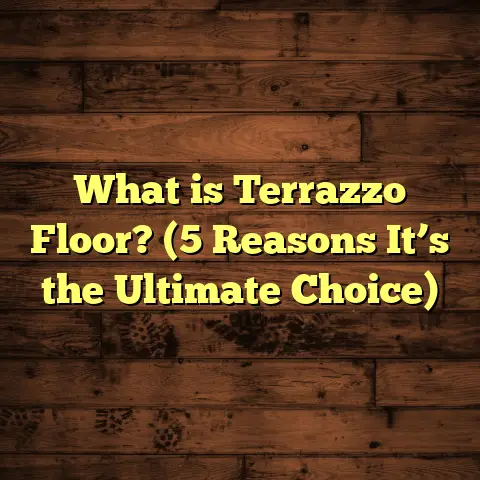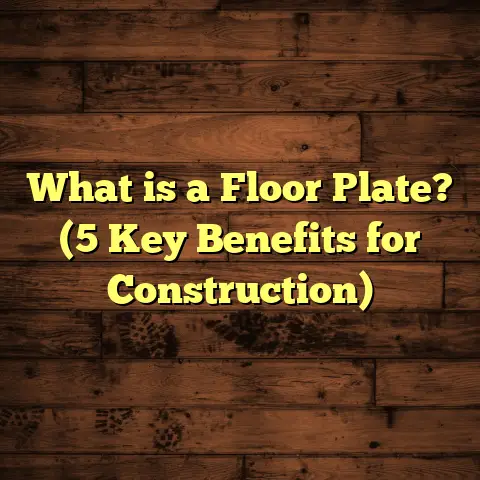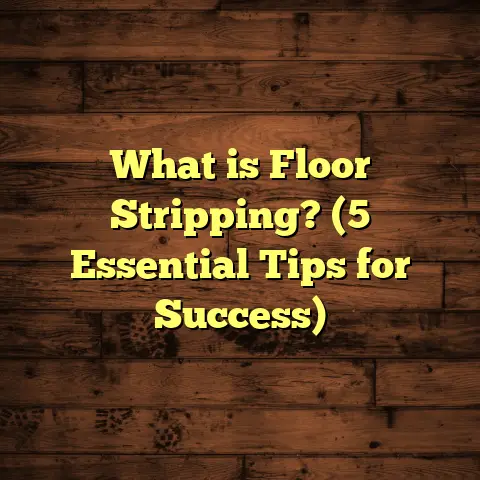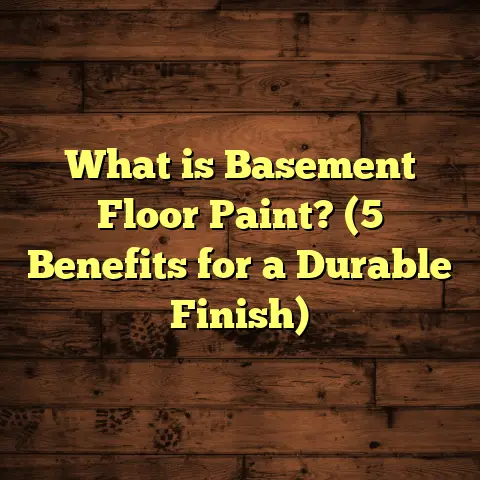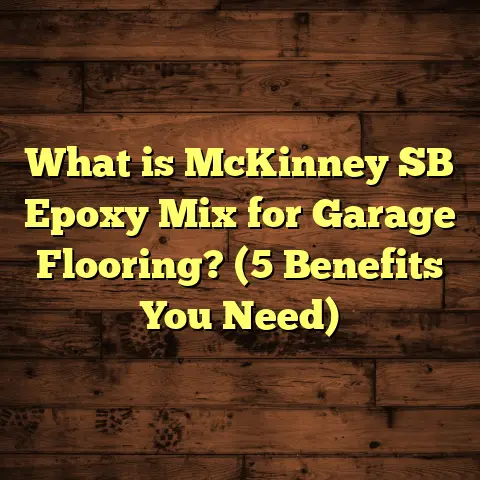What is Luxury Vinyl Flooring? (5 Benefits You Must Know!)
I always find it funny how people think luxury vinyl flooring is just “fancy plastic.” When I first started in the flooring business over a decade ago, I had a client say to me, “Why would I spend money on vinyl when I can get hardwood?” That stuck with me because, honestly, luxury vinyl flooring (or LVF) has come a long way since then. It’s no longer the cheap, thin stuff you see in old apartments. It’s a game-changer and, spoiler alert, it’s one of my favorite flooring types to install and recommend.
What Is Luxury Vinyl Flooring?
Luxury vinyl flooring is a type of resilient flooring designed to mimic the look of natural materials like hardwood or stone but with improved durability and ease of maintenance. It’s made up of several layers, typically including:
- A wear layer: This transparent top coat protects against scratches and stains.
- A decorative layer: Printed with high-resolution images of wood, stone, or tile patterns.
- A core layer: Often made from vinyl or a composite for stability and support.
- A backing layer: Provides additional strength and helps with sound absorption.
LVF comes mainly in two types: Luxury Vinyl Planks (LVP) and Luxury Vinyl Tiles (LVT). The planks are designed to replicate hardwood floors, usually sized around 6 to 9 inches wide and 36 to 48 inches long. The tiles mimic stone or ceramic tiles, often measuring 12×12 inches or 18×18 inches.
From my experience working across homes in Chicago and New York, LVF thickness commonly ranges from 2 mm to 8 mm. The thicker the plank or tile, the more comfortable it feels underfoot and the better it performs in high-traffic areas.
5 Benefits You Must Know About Luxury Vinyl Flooring
1. Durability That Surprises Everyone
You might think vinyl would scratch or dent easily, but luxury vinyl flooring is tougher than most hardwoods when it comes to daily wear. The wear layer on LVF provides excellent resistance to scratches, scuffs, and stains.
In one project I completed last year in a busy family kitchen in Boston, the homeowners had two young kids and a dog. After 18 months, the floor still looked practically new despite constant foot traffic and spilled foods. That wear layer is usually rated between 6 mil (thinner) to 20 mil (heavy-duty), and I always recommend at least 12 mil for families or commercial spaces.
Statistically speaking, a study from the National Floor Covering Association found that LVF lasts anywhere from 10 to 20 years with proper care, which is comparable to many engineered hardwood floors.
2. Water Resistance That Makes a Difference
If you’ve ever dealt with water damage on hardwood floors, you know how devastating it can be. Luxury vinyl flooring handles moisture like a champ because it’s made mostly from waterproof materials.
I installed LVF in a bathroom remodel in Florida where humidity levels hover around 80% all year. The floor stayed intact without warping or swelling—a problem that would have been costly with hardwood or laminate.
While not all LVF is fully waterproof, most brands offer waterproof versions perfect for kitchens, bathrooms, basements, and even laundry rooms.
3. Cost-Effective Without Sacrificing Style
One of the best things about luxury vinyl flooring is that it looks expensive without breaking your budget. Hardwood flooring can range from $8 to $14 per square foot installed depending on the species and finish. LVF usually costs between $3 and $7 per square foot installed, depending on thickness and brand.
I once helped a client in Seattle choose LVF that perfectly mimicked walnut wood planks for under $5 a square foot installed. She told me she saved nearly $10,000 compared to authentic hardwood but still got that warm, natural wood look she wanted.
Plus, you don’t have to sacrifice style. LVF comes in countless textures and finishes—from hand-scraped oak to polished marble—that can match almost any décor style.
4. Easy Installation That Saves Time
Having installed hundreds of flooring projects myself, I know firsthand how much time LVF saves compared to other options. It often comes with a click-lock design that floats over existing floors without needing glue or nails.
For example, I installed luxury vinyl planks in a New Jersey condo in just three days for about 800 square feet of living space. Hardwood installation for the same area usually takes about a week or more due to acclimation and finishing requirements.
This faster turnaround means less disruption for homeowners and quicker project completion — which everyone appreciates.
5. Maintenance That Fits Busy Lives
If you’re like most people I work with, cleaning floors isn’t your favorite chore. Luxury vinyl flooring makes this easy. It only needs regular sweeping or vacuuming plus occasional damp mopping with a gentle cleaner.
Unlike hardwood which requires refinishing every few years and careful protection from water, LVF can handle spills immediately without damage.
One of my clients in Dallas told me she loves how stress-free her new luxury vinyl floor is after years of worrying about her kids scratching their wood floor with toys.
Digging Deeper: Layers Explained
Let me break down those layers a bit more because they’re what really make luxury vinyl flooring stand out.
- The Wear Layer: Thickness here is king. A thicker wear layer means better scratch resistance and longer life span. For residential use, 12 mil is often enough but for commercial or heavy use areas I push for 20 mil or more.
- The Decorative Layer: This is where technology shines. The images are created using advanced printing techniques that replicate wood grain or stone veining so well that most people can’t tell the difference unless they look closely.
- The Core Layer: There are different core types – solid vinyl cores provide great waterproofing but can feel harder underfoot; wood-plastic composite cores add some cushion and warmth but may not be fully waterproof.
- The Backing Layer: Usually made from fiberglass or felt for sound absorption and added stability.
When I specify products for clients, I always check these layers carefully. It’s not just about looks — performance depends heavily on them.
How Does Luxury Vinyl Flooring Compare?
I’ve installed almost every type of flooring out there—hardwood, laminate, tile—and here’s how LVF stacks up:
| Flooring Type | Average Cost (installed) | Durability | Water Resistance | Installation Time | Maintenance |
|---|---|---|---|---|---|
| Hardwood | $8 – $14 / sq ft | Moderate (can dent) | Low | 7+ days (includes finishing) | Refinishing needed |
| Laminate | $3 – $8 / sq ft | Moderate | Low | 2-3 days | Easy but no water exposure |
| Tile | $5 – $15 / sq ft | High (cracks) | High | 4-7 days | Requires grout cleaning |
| Luxury Vinyl | $3 – $7 / sq ft | High | High | 2-4 days | Very low |
From my projects across various climates—especially humid ones like Florida or snowy areas like Minnesota—LVF stands out for its water resistance and ease of upkeep.
Installation Insights: What You Should Know
People often ask me if they can install luxury vinyl flooring themselves. The answer? Absolutely—if you’re comfortable with DIY projects—but here are some things to keep in mind:
- Subfloor Prep Is Key: LVF needs a flat, clean subfloor for best results. Uneven surfaces can cause planks to gap or click-lock joints to pop.
- Acclimation Time: Unlike hardwood which needs weeks to acclimate to room temperature and humidity changes, LVF generally requires about 24 hours.
- Expansion Gaps: Because LVF expands slightly with temperature changes, you need to leave a small gap (usually ¼ inch) around edges.
- Underlayment: Some LVF comes with attached underlayment which saves time; otherwise adding a quality underlayment improves sound absorption and comfort.
On one occasion installing in Houston’s high-rise condo building, prep was so crucial due to slight floor unevenness. We used self-leveling compounds first which took two days but ensured flawless results.
My Experience With Different Brands
I’ve worked with many brands over the years—Armstrong, Mannington, Shaw, COREtec, Karndean—and each has its own strengths.
For example:
- COREtec offers excellent waterproof cores good for basements.
- Karndean provides some of the most realistic wood textures I’ve seen.
- Armstrong tends to have budget-friendly options suitable for large projects.
I usually go by client needs: budget constraints, foot traffic levels, and desired look before recommending a brand.
Design Trends With Luxury Vinyl Flooring
LVF isn’t just practical; it’s also riding high on design trends:
- Wide Planks: Bigger planks (7-9 inches wide) mimic modern hardwood styles popular in urban apartments.
- Gray Tones: Gray wood patterns have become massively popular—they add a cool elegance that works well with minimalist décor.
- Distressed & Hand-Scraped Looks: These give rustic charm without the high cost or maintenance issues of real wood.
- Mixed Widths: Some manufacturers now offer mixed-width plank boxes to add visual interest similar to custom hardwood floors.
I recently helped remodel a loft in Brooklyn using gray wide plank LVP—it looked gorgeous against white walls and industrial fixtures.
Care Tips That Keep Your LVF Looking Great
Keeping your luxury vinyl floor pristine isn’t rocket science:
- Sweep or vacuum regularly to remove dirt that can scratch.
- Use a damp mop with pH-neutral cleaners specifically made for vinyl floors.
- Avoid abrasive tools or harsh chemicals.
- Clean spills quickly to prevent any staining—even though LVF is stain-resistant.
- Place protective pads under furniture legs to avoid dents.
A client in Phoenix once spilled red wine during a dinner party—I reassured her that LVF’s wear layer would protect the floor if cleaned promptly. Sure enough, no stain remained after mopping right away.
Cost Breakdown: What You Can Expect
Here’s a rough breakdown based on my recent projects around the US:
| Item | Cost Range (USD) |
|---|---|
| Material (per sq ft) | $2.00 – $5.00 |
| Installation (per sq ft) | $1.00 – $3.00 |
| Underlayment (optional) | $0.50 – $1.00 per sq ft |
| Removal of old floor | $1.00 – $2.00 per sq ft |
| Total Installed Cost | $3.50 – $7.00 per sq ft |
These numbers vary depending on location—labor rates are higher in cities like New York or San Francisco versus smaller towns.
Real-Life Case Study: Family Home Renovation
A family of five in suburban Atlanta wanted new floors throughout their main level: kitchen, living room, and hallway—about 1,500 square feet total.
They wanted something stylish but able to withstand kids’ activity and pets while staying budget-friendly.
We chose an LVP with a 15 mil wear layer featuring hand-scraped oak visuals at $4 per sq ft material cost plus $2 installation.
The entire project took four days from removal of old carpet to finished floor.
After six months, they reported zero scratches or damage despite lots of playtime—and loved how easy cleanup was after spills at dinner parties.
Common Questions I Get About Luxury Vinyl Flooring
Q: Can luxury vinyl flooring go over existing tile?
A: Yes! As long as the tile surface is level and intact, LVF can be floated over existing tiles—saving time on demolition.
Q: How long does luxury vinyl flooring last?
A: Typically 10-20 years depending on wear layer thickness and maintenance habits.
Q: Is LVF good for radiant floor heating?
A: Yes! Many luxury vinyl products are compatible with radiant heating systems but check manufacturer specs first.
Q: Can I use wax or polish on my luxury vinyl floor?
A: No waxes are needed; these can actually damage the wear layer over time.
I hope my sharing gives you a clear picture of why luxury vinyl flooring continues winning over homeowners across the country—including me as someone who’s seen every kind of floor out there!
If you’re thinking about new floors for your home or business and want something durable,
stylish,
and affordable,
LVF deserves serious thought.
Got questions? Want tips for your specific project? Just ask — I’m here to help!
